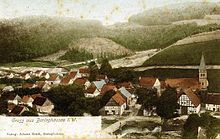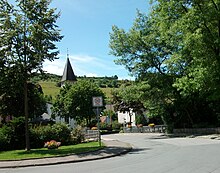St. Markus (Beringhausen)
The Catholic parish church of St. Markus is a church building in Beringhausen , a district of the city of Marsberg in the Hochsauerlandkreis ( North Rhine-Westphalia ). Parts of the church furnishings are under monument protection .
Old church
The old church was built in the 13th century and demolished in 1922. It is preserved in drawings and photographs. The building was located on the southern slope of the Hoppecketal and was surrounded by a churchyard bordered by stone walls. Remnants of the church are no longer recognizable. The Romanesque building was single-nave with two bays . The narrower choir was almost square. Quarry stone cross vaults were drawn in between angular belt and shield arches . In the Baroque period, an extension with weaker walls and a wooden ceiling with Rabitz vault was built in front of the vaulted part . A gallery was built around the same time . The church was built into a slope. One got through the arched main entrance on the north side over a few steps into the church interior. The low choir was raised by six steps, which were as wide as the central bay. The men's gallery could be reached through a door in the south wall via a flight of stairs in the higher cemetery. A mighty roof turret in a slate framework was placed on the west side. It was almost square, with its helmet tapering off as an octagonal point. On the village side it was divided by four sound openings . The roof was also covered with slate. The originally small Romanesque windows were enlarged in the Baroque period and covered with segmental arches. In the east wall of the choir the brickwork of a Gothic window could be seen.
Equipment of the old church
According to the recording of a dean Caspari, the following items were previously still present:
- Two bells , the larger one has a diameter of 79.5 cm. It is inscribed in Gothic minuscule: st. joannes is called ick, doner vnde hagel I break. Jhesus. Anno dni 1483 . The other bell has a diameter of 77 cm and bears the inscription in the same letters: St. Maria sy ick called, my geloit sy gode bekant. Jhesus. 1483. The bells were probably melted down.
- A cast iron grave slab for Pastor Ortmann, who died in 1686. The plate was placed in the choir above his grave and bore the inscription: VNVS ES, O IESV, FACIENS, NOS ESSE BEATOS. PER TE MIRA QVIES, NON ALIVNDE VENIT (1686). EX TE ERGO QVIES; O JESV, AETERNA JOANNI CONRADO ORTMANN, PASTORI INTUS SEPULTO . The grave slab was probably melted down along with the bells.
New Church
The new church was built from 1886 to 1887 in a romanised form. The three-aisled hall church with a square west tower is equipped with a semicircular apse . The quarry stone building was plastered. The forged cross on the tower originally comes from the monastery church in Bredelar . The old weather vane on the attached sacristy shows the coat of arms of Brilon . The origin is unknown. An old, wrought-iron, richly decorated cross was placed on the choir roof.
Equipment of the new church
- The baptismal font from sandstone in cup form, dates from the 17th century. The base has the shape of an eight-sided, Gothic chapel . The tracery windows are open and the eyelashes are 33 cm high. The lid was made of wood. The font is 138 cm high with the lid.
- The softwood lecture cross is from the 16th century. The body is 48 cm long, the arm span is also 48 cm.
- The carved representation of the Immaculate Conception from the beginning of the 18th century shows Mary in a flowing cloak, which she holds together in front of her breast. The 60 cm high figure stands on a 30 cm high ball with a snake and a crescent moon. Under the ball you can see three winged angel heads. The figure is said to have hung in the triumphal arch of the old church.
- St. Veronica with the handkerchief of Christ and St. Anthony of Padua are rough peasant sculptures from the late 18th century.
literature
Paul Michels, Nikolaus Rodenkirchen, Franz Herberhold: Architectural and art monuments of Westphalia, Brilon district , Volume 45, Aschendorfsche Verlagbuchhandlung, Münster (Ed .: Wilhelm Rave, state curator) 1952
Web links
- Photo and story (PDF; 129 kB)
Individual evidence
- ^ Paul Michels, Nikolaus Rodenkirchen, Franz Herberhold, Architectural and Art Monuments of Westphalia, Brilon District , Volume 45, Aschendorfsche Verlagsbuchhandlung, Münster (Ed .: Wilhelm Rave) 1952, pp. 88–91
See also
Coordinates: 51 ° 24 ′ 28 " N , 8 ° 45 ′ 14" E



